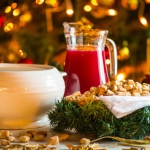News
Lithuanian Christmas tradition – Kucios
12/21/2021
The Associated Press shares the stories of the holiday, with one from colleague Adolphe Bernotas on Kucios, the ancient Lithuanian celebration of the winter solstice.
Adolphe Bernotas -
I wrote a version of this Christmas story soon after I retired from AP. I update it periodically and share it around the year-end holidays with new friends (as those in Connecting). I haven't prepared the described feast for at least 30 years. Attendance to scaled-down public celebrations of Kucios in Lithuanian communities has replaced my labor-intensive home-grown variety.
Part of the fun of Kucios, the ancient Lithuanian celebration of the winter solstice, used to be to guess which of my guests are wondering when can they leave the table and hit McDonald's.
I never took offense. For meat-and-potato Americans, a platter of beet, egg and herring salad and a bowl of cranberry pudding washed down by a purple-gray milk made from macerated poppy seeds doesn't much resemble a Christmas Eve feast.
But for me, it reconnects me to who I am -- one of about 5 million people around the world who speak a singular language from a tiny nation where centuries of occupying armies haven't crushed the identity of its people.
And once my guests were courageous enough to try these foods, they often agreed that the dishes were quite palatable.
Perhaps some overcame their initial aversion to the poppy seed milk. And that group usually asked for seconds of the frothy, sweet drink that tastes of almonds and poppy seeds.
But so labor intensive is the Kucios (pronounced coo-chuss) meal, that I haven't prepared the celebration in decades. I used to take at least a week of vacation before Christmas to assemble and prepare the Christmas Eve-only foods.
This typically meant driving to Boston or New York to get proper herring and smoked fishes. Plus, I would return to my New World-home American-Lithuanian community in Waterbury, Conn., to get the best Lithuanian rye bread this side of Kaunas, city of my birth.
(My most recent participation in Kucios was a pre-Covid Christmas gathering two years ago at the American-Lithuanian Club in St. Petersburg, Florida).
Kucios dates to around 2000 B.C., when Lithuanians settled along the Baltic Sea. They celebrated to pay homage to the sun as winter's short days waned. It was a unifying ritual that included all beings -- people, animals, plants, spirits and gods.
But much of what Lithuanians now celebrate as Kucios has been influenced by Christianity. Lithuania, which sits at the geographical center of Europe, was the last nation on the continent to accept Christianity, formally in 1386.
The Roman Catholic Church adjusted the pagan celebration of light into the observance of Christmas. Pre-Christian Kucios required the eating of nine foods, reflecting the nine-day weeks of the lunar calendar. Under Christianity, 12 are served to recognize the 12 apostles.
And while ancient Lithuanians included meat and ceremonial mead in their feasts, under Christian observance the feast became a fast from meat, even milk (substituted by the poppy seed beverage.)
The setting matters, too. The room where the meal is eaten must have as much light as possible. Straw and a cross are placed on the table under a white tablecloth as a symbol of the creche in which Christ was born.
An empty setting is left at the table for those who died during the year, strangers or those who could not be home for the feast. The day is meant for contemplation and communion with the family. "I" is discouraged; "we" is encouraged.
The meal begins with the rising evening star. Diners stand for a prayer, consume a special communion host that has been blessed by the parish priest, and family members wish each other good fortune. My wishes used to include the return of freedom to my native land, which the Lithuanians regained with the collapse of the Soviet Union.
The most important food is the kucia (coo-cha), a porridge of grains, peas, beans, nuts, poppy and hemp seeds mixed with honey-sweetened water. All who sit at the table -- as well as the household and farm animals – must taste it.
In fact, everyone must taste everything. Tradition says that those who skip any of the Kucios foods will not live to see the next Christmas.
Fishes, especially herring recipes ranging from smoked to baked to marinated, make up much of the 12-course menu.
Depending on the region, other foods might include mushroom dumplings, carrots, nuts, honey, apples, cabbage with peas, beans, onion and beet soups and salads, potatoes seasoned with hemp or flax seed salt, pudding from fermented oatmeal and (a favorite at my table) cranberry pudding.
After the meal, the table is left uncleared until morning to leave food for the souls of ancestors, spirits and gods. And the fire in the hearth cannot be allowed to die.
My sisters and I haven't shared Kucios for many years, As children we would argue whether indeed, according to our parents and folklore, animals at the moment of midnight would converse in language understandable to people. We were too young to stay up to find out.

